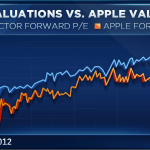
While most investors look at mutual fund and ETF prices as a gauge of success, flows — the money going in and out — is sometimes a better indicator of investor sentiment. Despite the market fluctuations, it was another big year for ETFs in 2015: Money flowed into equity and bond ETFs, while money flowed out of mutual funds.
Here are the major trends for 2015:
1) The big trend continues: Money flowing out of mutual funds, and into ETFs. According to Thomson Reuters, as of Dec.23, roughly $150 billion flowed out of mutual funds (all equities, bonds, money market and municipal funds), while ETFs saw $150.6 billion inflows.
It’s probably a coincidence that there was $150 billion outflows from mutual funds and $150 billion inflows into ETFs, but the trend has been going on for years.
Why inflows on the ETF side and outflows on the mutual fund side?
The inability of active managers to outperform indices; the lower cost of owning ETFs: that lower cost is a critical factor, which is more investment advisors are also using ETFs in an effort to drive down their own fees to investors; the increasing use of ETFs as “tactical” investment by professional traders such as hedge funds.
Some have also postulated that in periods of higher volatility — which we saw during some months in 2015 — market makers can create more ETFs solely for the purpose of shorting the markets, shares which eventually have to be bought back. This may be a small factor as well.
By the way, ETFs still can’t match mutual funds for assets under management: There’s roughly $11.5 trillion invested in mutual funds (all equities, bonds, and municipal funds), while there’s only roughly $2.1 trillion in ETFs. But ETFs had only $1 trillion under management a few years ago, and the trend toward ETFs continued in 2015, though at a somewhat slower pace.
2) Equities. Several sectors indicate a divergence in thinking between mutual fund investors–which might be said to represent the “average” investor — and ETF investors, which might be said to represent the “sophisticated” investor (professional traders, day traders and other more “active” traders).
For example, mutual fund investors pulled money out of Real Estate in 2015, but added a small amount of money in ETFs.
Mutual fund investors added a small amount of money into energy in 2015, but ETF investors added a significant amount, suggesting ETF investors were still trying to bet on an Energy rebound.
The point is that more sophisticated investors are trying to use ETFs in “tactical” ways, that is, using ETFs to move more quickly in and out of investments to seek higher returns.
3) Bonds. You can see this divergence in thinking between mutual fund and ETF investors in bonds as well. Mutual fund bond holders reduced their holdings of high yield funds, but ETF high yield investors still had a small add for the year. The same was true with investment grade corporate bonds: there were outflows from mutual fund holders, and inflows from ETF investors.
This suggests that the average mutual fund investor was clearly trying to get out of the way of the Fed’s rate hike cycle, but more sophisticated investors — professional traders and active traders — seemed to be betting that the Fed’s rate hike cycle would be relatively modest.
4) International equities. With Europe outperforming all year, it was another big year for currency-hedged strategies. There were fairly large inflows into two European ETFs that hedge their currency exposure: WisdomTree Europe Hedged Equity and the Deutsche X-trackers MSCI EAFE.
With the Fed poised to raise rates — a move usually damaging to Emerging Markets — it’s no surprise there were outflows from the two biggest Emerging Market ETFs, iShares Emerging Markets andVanguard Emerging Markets.
5) ETF investors are becoming very sensitive to fees, and are willing to move money around to get lower fees. Two ETFs that track the same indices — the S&P 500 — had very different flows in 2015. The SPDR S&P 500 ETF — the biggest ETF in the world, with roughly $180 billion in assets under management — had outflows of roughly $36 billion, while the Vanguard 500 ETF had inflows of $12.6 billion, according to Morningstar.
Why? Vanguard is a retail operation, so partly this is more proof of the triumph of the average investor continuing to move money from mutual funds into ETFs.
But there’s another factor that may play a part in this: Lower fees. Vanguard’s 500 ETF charges 0.05 percent, versus 0.09 percent for SPY. This doesn’t sound like much — it amounts to a fee differential of $4 for every $10,000 invested per year, but ETF investors have shown a surprising willingness to move money around for even small savings.
[“source -cncb”]




